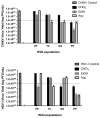Antiviral Potential and Chemical Composition of Wild Baccharis crispa Spreng. Populations (Asteraceae) from Córdoba, Argentina: Perspective on Population Variability
- PMID: 39519995
- PMCID: PMC11548641
- DOI: 10.3390/plants13213077
Antiviral Potential and Chemical Composition of Wild Baccharis crispa Spreng. Populations (Asteraceae) from Córdoba, Argentina: Perspective on Population Variability
Abstract
Medicinal plants have been explored worldwide as potential alternatives for the prevention and treatment of different diseases, including viral infections. Baccharis crispa Spreng. (Asteraceae) is a native medicinal species widely used in South America. Given the influence of genetic and environmental factors on secondary metabolites biosynthesis and accumulation, this study aimed to evaluate the in vitro antiviral activity of four wild populations of B. crispa from Córdoba, Argentina, and assess the variability in their bioactivity and chemical composition. The cytotoxicity of chloroform, ethanol, and aqueous extracts from aerial parts was evaluated by the neutral red uptake method. Antiviral and virucidal activity against herpes simplex virus type 1 (HSV-1) and chikungunya virus (CHIKV) were assessed via plaque-forming unit (PFU) reduction assay. Phytochemical analyses of the extracts were conducted using HPLC-ESI- MS/MS. The Puesto Pedernera population showed the strongest antiviral activity, with inhibition rates of 82% for CHIKV and 79% against HSV-1, as well as potent virucidal effects, reducing PFU formation by up to 5 logarithms for both viruses. Remarkably, ethanol extract exhibited the least toxicity and strongest inhibitory activity. Villa del Parque population was inactive. We identified 38 secondary metabolites, predominantly phenolic acids (12) and flavonoids (18), in varying proportions. Delphinidin and delphinidin-3-glucoside are described for the first time in the species. Differences in phytochemical profiles were observed among extract types and populations. Key phenolic compounds showed moderate positive correlations with the evaluated bioactivities, emphasizing the complexity of phytochemical properties and interactions. These results highlight the therapeutic potential of B. crispa extracts against viral infections and underscore the importance of considering the geographical source of plant material in bioactivity evaluations.
Keywords: bioactivities; chikungunya virus; herpes simplex virus; natural products; population variability.
Conflict of interest statement
The authors declare no conflicts of interest. The funders had no role in the design of the study, in the collection, analyses, or interpretation of data, in the writing of the manuscript, or in the decision to publish the results.
Figures




Similar articles
-
Amazonian medicinal plants efficiently inactivate Herpes and Chikungunya viruses.Biomed Pharmacother. 2023 Nov;167:115476. doi: 10.1016/j.biopha.2023.115476. Epub 2023 Sep 15. Biomed Pharmacother. 2023. PMID: 37713986
-
Antiviral Potential of Chiococca alba (L.) Hitchc. Plant Extracts Against Chikungunya and Mayaro Viruses.Int J Mol Sci. 2024 Oct 23;25(21):11397. doi: 10.3390/ijms252111397. Int J Mol Sci. 2024. PMID: 39518948 Free PMC article.
-
In vitro antiviral activity of plant extracts from Asteraceae medicinal plants.Virol J. 2013 Jul 27;10:245. doi: 10.1186/1743-422X-10-245. Virol J. 2013. PMID: 23890410 Free PMC article.
-
Chemical analysis and antiviral activity evaluation of Baccharis anomala.Nat Prod Res. 2018 Aug;32(16):1960-1962. doi: 10.1080/14786419.2017.1354186. Epub 2017 Jul 19. Nat Prod Res. 2018. PMID: 28722502
-
Ethnomedicinal, phytochemical and pharmacological investigations of Baccharis dracunculifolia DC. (ASTERACEAE).Front Pharmacol. 2022 Nov 28;13:1048688. doi: 10.3389/fphar.2022.1048688. eCollection 2022. Front Pharmacol. 2022. PMID: 36518668 Free PMC article. Review.
References
-
- WHO . Managing Epidemics: Key Facts About Major Deadly Diseases. World Health Organization; Geneva, Switzerland: 2018.
Grants and funding
LinkOut - more resources
Full Text Sources

